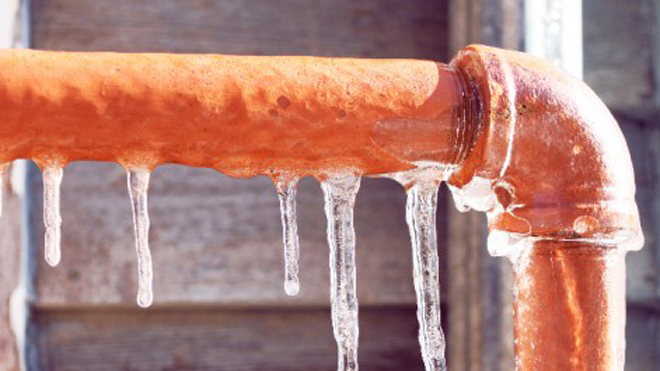Guidance for Avoiding Frozen Pipes in Cold Weather: Expert Tips
Guidance for Avoiding Frozen Pipes in Cold Weather: Expert Tips
Blog Article
They are making several good annotation related to 6 Ways to Prevent Frozen Pipes overall in this great article directly below.

Cold weather can ruin your pipes, especially by freezing pipes. Here's exactly how to prevent it from taking place and what to do if it does.
Introduction
As temperature levels drop, the risk of icy pipes boosts, possibly causing costly repair services and water damages. Understanding exactly how to stop frozen pipes is critical for property owners in chilly environments.
Prevention Tips
Protecting at risk pipes
Wrap pipes in insulation sleeves or utilize warmth tape to safeguard them from freezing temperatures. Concentrate on pipelines in unheated or outside locations of the home.
Home heating strategies
Keep interior spaces sufficiently heated up, particularly areas with pipes. Open up closet doors to enable cozy air to distribute around pipes under sinks.
How to identify icy pipelines
Try to find decreased water circulation from taps, unusual odors or sounds from pipelines, and visible frost on subjected pipelines.
Long-Term Solutions
Structural adjustments
Consider rerouting pipelines far from exterior wall surfaces or unheated areas. Add added insulation to attics, basements, and crawl spaces.
Updating insulation
Invest in top quality insulation for pipes, attic rooms, and walls. Correct insulation assists maintain constant temperature levels and reduces the threat of icy pipelines.
Safeguarding Outdoor Plumbing
Garden hoses and outdoor taps
Disconnect and drain pipes yard hose pipes prior to wintertime. Mount frost-proof spigots or cover outdoor faucets with protected caps.
Understanding Icy Pipes
What triggers pipelines to ice up?
Pipelines ice up when exposed to temperatures listed below 32 ° F (0 ° C) for prolonged periods. As water inside the pipelines ices up, it broadens, taxing the pipeline wall surfaces and possibly triggering them to rupture.
Dangers and problems
Frozen pipelines can bring about water supply disruptions, residential property damages, and costly repair work. Burst pipes can flooding homes and trigger substantial structural damage.
Signs of Frozen Piping
Recognizing frozen pipelines early can stop them from bursting.
What to Do If Your Pipelines Freeze
Immediate activities to take
If you think icy pipes, maintain taps available to relieve stress as the ice melts. Utilize a hairdryer or towels soaked in warm water to thaw pipes gradually.
Conclusion
Stopping frozen pipes calls for positive measures and quick feedbacks. By comprehending the reasons, signs, and safety nets, homeowners can safeguard their pipes throughout cold weather.
6 Proven Ways to Prevent Frozen Pipes and Protect Your Home
Disconnect and Drain Garden Hoses
Before winter arrives, start by disconnecting your garden hoses and draining any remaining water. Close the shut-off valves that supply outdoor hose bibs and leave the outdoor faucet open to allow any residual water to drain. For extra protection, consider using faucet covers throughout the colder months. It’s also important to drain water from any sprinkler supply lines following the manufacturer’s directions.
Insulate Exposed Pipes
Insulating your pipes is an effective way to prevent freezing. Pipe insulation is readily available at home improvement stores and is relatively inexpensive. Pay close attention to pipes in unheated areas such as the attic, basement, crawl spaces, or garage. Apply foam insulation generously to create a buffer against the cold. You can also wrap your pipes in heat tape or thermostat-controlled heat cables for added warmth.
Seal Air Leaks
Inspect your home for any cracks or openings that could let in cold air. Seal any holes around the piping in interior or exterior walls, as well as the sill plates where your home rests on its foundation. Additionally, make sure to keep your garage door closed unless you’re entering or exiting. Leaving it open creates a significant air leak that can lead to frozen pipes.
Allow Warm Air Circulation
During cold snaps, it’s essential to allow warm air to circulate evenly throughout your home. Leave interior doors ajar to promote better airflow. Open kitchen and bathroom cabinets to help distribute heat consistently around the rooms. If you have small children or pets, be sure to remove any household chemicals or potentially harmful cleaners from open cabinets for safety.
Let Faucets Drip
A small trickle of water can make a big difference in preventing ice formation inside your pipes. When temperatures drop significantly, start a drip of water from all faucets served by exposed pipes. This continuous flow helps prevent the water from freezing. Additionally, running a few faucets slightly can relieve pressure inside the pipes, reducing the chances of a rupture if the water inside does freeze.
https://choateshvac.com/6-proven-ways-to-prevent-frozen-pipes-and-protect-your-home/

Do you like more info about How To Avoid Freezing Pipes? Create a remark below. We will be glad to listen to your ideas about this blog post. We are looking forward that you visit us again soon. Don't hesitate to set aside a second to share this blog post if you enjoyed reading it. Thanks a lot for going through it.
Schedule Report this page